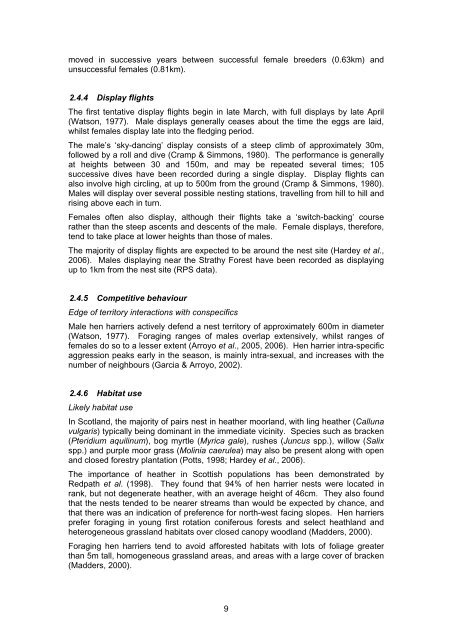Literature review to assess bird species connectivity to Special ...
Literature review to assess bird species connectivity to Special ...
Literature review to assess bird species connectivity to Special ...
Create successful ePaper yourself
Turn your PDF publications into a flip-book with our unique Google optimized e-Paper software.
moved in successive years between successful female breeders (0.63km) and<br />
unsuccessful females (0.81km).<br />
2.4.4 Display flights<br />
The first tentative display flights begin in late March, with full displays by late April<br />
(Watson, 1977). Male displays generally ceases about the time the eggs are laid,<br />
whilst females display late in<strong>to</strong> the fledging period.<br />
The male’s ‘sky-dancing’ display consists of a steep climb of approximately 30m,<br />
followed by a roll and dive (Cramp & Simmons, 1980). The performance is generally<br />
at heights between 30 and 150m, and may be repeated several times; 105<br />
successive dives have been recorded during a single display. Display flights can<br />
also involve high circling, at up <strong>to</strong> 500m from the ground (Cramp & Simmons, 1980).<br />
Males will display over several possible nesting stations, travelling from hill <strong>to</strong> hill and<br />
rising above each in turn.<br />
Females often also display, although their flights take a ‘switch-backing’ course<br />
rather than the steep ascents and descents of the male. Female displays, therefore,<br />
tend <strong>to</strong> take place at lower heights than those of males.<br />
The majority of display flights are expected <strong>to</strong> be around the nest site (Hardey et al.,<br />
2006). Males displaying near the Strathy Forest have been recorded as displaying<br />
up <strong>to</strong> 1km from the nest site (RPS data).<br />
2.4.5 Competitive behaviour<br />
Edge of terri<strong>to</strong>ry interactions with conspecifics<br />
Male hen harriers actively defend a nest terri<strong>to</strong>ry of approximately 600m in diameter<br />
(Watson, 1977). Foraging ranges of males overlap extensively, whilst ranges of<br />
females do so <strong>to</strong> a lesser extent (Arroyo et al., 2005, 2006). Hen harrier intra-specific<br />
aggression peaks early in the season, is mainly intra-sexual, and increases with the<br />
number of neighbours (Garcia & Arroyo, 2002).<br />
2.4.6 Habitat use<br />
Likely habitat use<br />
In Scotland, the majority of pairs nest in heather moorland, with ling heather (Calluna<br />
vulgaris) typically being dominant in the immediate vicinity. Species such as bracken<br />
(Pteridium aquilinum), bog myrtle (Myrica gale), rushes (Juncus spp.), willow (Salix<br />
spp.) and purple moor grass (Molinia caerulea) may also be present along with open<br />
and closed forestry plantation (Potts, 1998; Hardey et al., 2006).<br />
The importance of heather in Scottish populations has been demonstrated by<br />
Redpath et al. (1998). They found that 94% of hen harrier nests were located in<br />
rank, but not degenerate heather, with an average height of 46cm. They also found<br />
that the nests tended <strong>to</strong> be nearer streams than would be expected by chance, and<br />
that there was an indication of preference for north-west facing slopes. Hen harriers<br />
prefer foraging in young first rotation coniferous forests and select heathland and<br />
heterogeneous grassland habitats over closed canopy woodland (Madders, 2000).<br />
Foraging hen harriers tend <strong>to</strong> avoid afforested habitats with lots of foliage greater<br />
than 5m tall, homogeneous grassland areas, and areas with a large cover of bracken<br />
(Madders, 2000).<br />
9

















